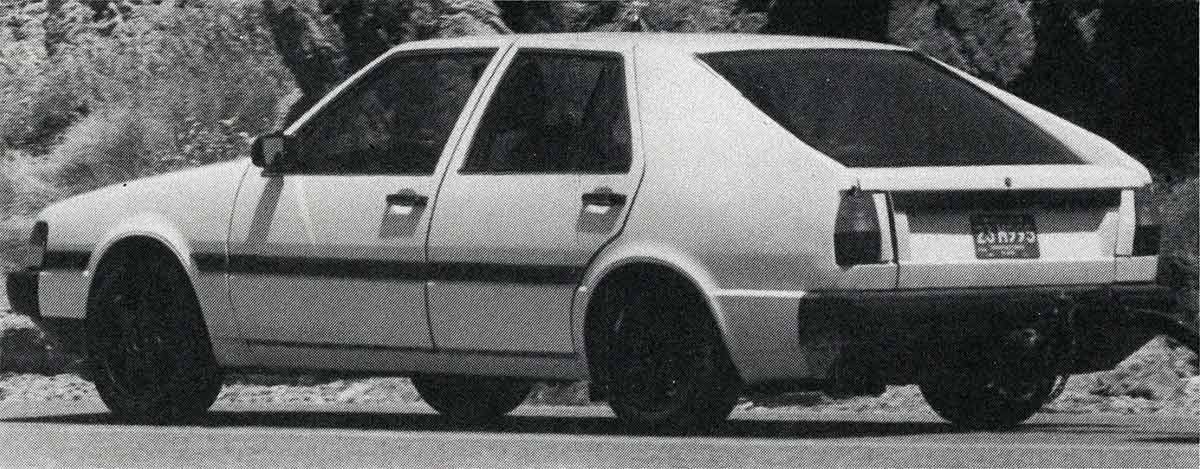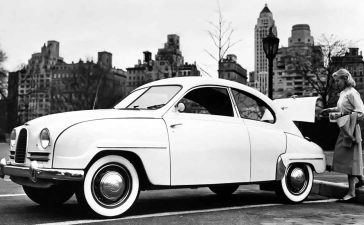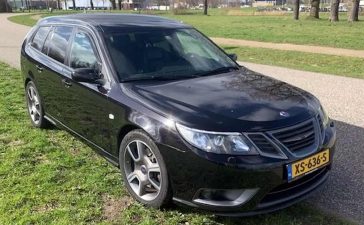Table of Contents
A Clandestine Reveal in the Mojave
In an unexpected twist of fate, “Motor Trend” journalists, while roaming the arid plains of the Mojave Desert, chanced upon a test fleet that would mark a pivotal moment in automotive history. This was the birth of the Saab 9000, an event shrouded in secrecy and masterful engineering. The Saab engineers were there to push the limits of their newest creation, conducting rigorous cooling and towing tests in punishing conditions, all under the guise of a familiar Saab 900 hatchback.
Ingenious Camouflage: A Sedan in Hatchback’s Clothing
To the untrained eye, the test mules captured in the grainy photographs (phots by Hans G. Lehman) bore a striking resemblance to the established Saab 900. But these were no ordinary vehicles. Underneath the deceptive skin—complete with Lancia Delta (Saab 600) tail-lamps and sail-panel quarter window covers—lay a bold new direction for Saab. The 9000 series was a cleverly disguised prototype of an upper-class sedan that would soon challenge the conventions of Swedish automotive design.
The Synergy of Collaboration: Crafting the 9000
The vehicle caught on camera was a testament to collaborative innovation, built on the Type Four platform developed with Fiat. This was a new frontier for Saab, a blending of shared knowledge and technological prowess. The sedan’s exterior might have mirrored the past, but beneath the surface, it was a forward-looking beacon of advancement, showcasing Saab’s intent to break into the realm of luxury sedans.

Mechanical Evolution: Under the Hood of the Saab 9000
“Motor Trend’s” images gave the world a sneak peek of what was to come. The prototype housed a 2.0-liter 16-valve twin-cam engine, a heart ready to beat at the core of Saab’s new direction. This engine, positioned over the transaxle for better weight distribution, represented a significant shift from previous models, aligning with the likes of Audi in terms of mechanical layout and expectations of performance.

Forward-Thinking Suspension: A Ride Refined
The Saab 9000 was not just about power and luxury; it was also about redefining the driving experience. Opting for MacPherson struts upfront, the model was building on the structural successes of its contemporaries, aiming to provide a ride that balanced responsiveness with the comfort of a top-of-the-line model. This engineering choice suggested that Saab was preparing to offer a vehicle that could rival the established comfort of models like Volvo’s 760 GLE.
The Dawn of a New Era for Saab
The Motor Trend feature from the Mojave Desert was more than just a glimpse at a new car; it was the first chapter in the story of the Saab 9000 series. With its innovative design, collaborative roots, and mechanical sophistication, the 9000 was set to carve a new path for Saab.
These early photographs and reports did not just capture a vehicle; they captured the moment Saab charted a course for the future—a future where it would stand as a paragon of luxury and performance in the automotive world.











I actually remember the photos from the time before 9k was launched…
Saab in cooperation with Fiat.
They called the project Euro car.
On the Croma, Lancia, Alfa platform.
Only the rear suspension has nothing to do with Alfa, Lancia Thema.
A simple steel tube and two wheels, that’s the rear suspension of the Saab 9000.
Alfa, Lacia Thema is completely different.
More technical possibilities.
In wheel traction and adjustments at Alfa 164, Lancia Thema.
TO Tomislav Peric> Stil the 9000 four linked rear suspension where more advanced and gave better road abilities. Built in anti dive, stiffer and more robust.
I had 2 best cars I have ever had in my life.Should not have sold the last one 😞
With Lancia Delta taillights 🙂
Auf der gleichen Plattform wie der Fiat Croma, Lancia Thema und der Alfa Romeo 164.